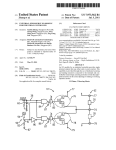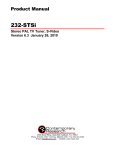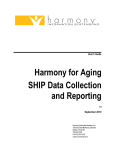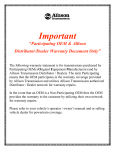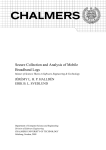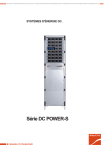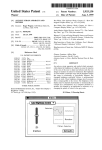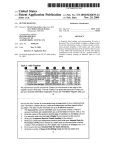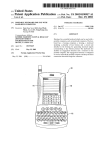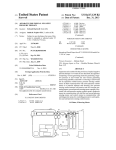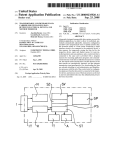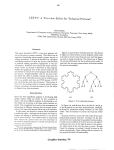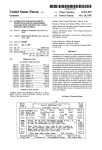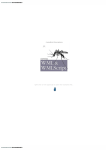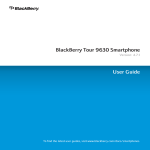Download System and method for secured data transfer over a network from a
Transcript
US 20100131764Al (19) United States (12) Patent Application Publication (10) Pub. No.: US 2010/0131764 A1 Goh (43) Pub. Date: (54) SYSTEM AND METHOD FOR SECURED (30) May 27, 2010 Foreign Application Priority Data DATA TRANSFER OVER A NETWORK FROM A MOBILE DEVICE May 3, 2007 (SG) ............................. .. 200703161-0 Publication Classi?cation (75) Inventor: Chuan Iau Goh, Singapore (SG) (51) Int CL H04L 9/32 Correspondence Address; (52) KNOBBE MARTENS OLSON & BEAR LLP 2040 MAIN STREET, FOURTEENTH FLOOR IRVINE, CA 92614 (Us) (57) (2006.01) US. Cl. ...................................................... .. 713/171 ABSTRACT A secured data transfer system (10) and method is disclosed in accordance with an embodiment of the invention that . _ . (73) Asslgnee' enables sensitive data to be securely exchanged from a user/ Ezypay PTE Ltd’ Smgapore (SG) client’s mobile device (12), phone, personal digital assistant (PDA), or the like to a back-end host (28), ?owing through (21) Appl. No.: 12/598,396 many hops and points in an public network, for example the Internet and/or in applications such as service provider’s - (22) _ wireless networks, without being exposed to any security PCT Flled' Apr‘ 30’ 2008 gaps in between servers. The system and method provides a PCT/SG08/00147 end, bank-grade secured transaction exchange between the user/client’s mobile device (12) and the back-end host (28) and using caching method for network tra?ic data reduction techniques. secure solution that plugs the gaps and ensures a true end-to (86) PCT No.: § 371 (c)(1), (2), (4) Date: Oct. 30, 2009 16 Application Server Telco's 3G/Gprs/Sms Network 10 Merchant A Merchant B Patent Application Publication May 27, 2010 Sheet 1 0f 7 US 2010/0131764 A1 16 Application Sewer Telco's 3G/Gprs/Sms Network Merchant A Merchant B FIG. 1 K 12 MOBILE DEVICE 14 K 16 ' ' APPLICATION C 28 HOST SERVER 4/? L Q \ 26 A’ 26 s 2 s 2 M M FIG. 2 Patent Application Publication May 27, 2010 Sheet 2 0f 7 12,13 14 7 Client’s I 'Midlet 16 US 2010/0131764 A1 182022242628 \ I Telco GWi Operator Server 1 Fl/Bank Host RSA key pair is generated by the operators HSM / )Fl/Bank's Key 1 2 141 / 142 / injected into the provider’s HSM 143 ‘______ 3 Before entering of sensitive / Pass thru data (eg PIN), midlet requests operator for RSA Telco’s secured Public Key. Server 4 > Pass thru Telco's App Sewer generates a random Sewer Seed. secured Download Random Server ) Server Seed + Fl‘s Public Key 145 \ according to Clients Fl ‘ 5 Midlet received Seed and Key. Open form for user to enter sensitive data (PIN, Password, ..etc) 144 selection. / 146 ' (/ 147 ‘ 148 Midlet generates Client seedc/ (optional). 6 (/ 149 Using Client(optional) and Public Key, Midlet encrypts(‘ee- 150 the sensitive data using OAEP RSA encryption algorithm. 7 8 Send encrypted transaction together with Client Seed (optional) to Apps Sewer. ( Pass thru Teloo's secured Sjmer A, \ Upon receiving encrypted transaction, Apps Sewer C/ 152 151 format and pass message to HSM for validate of seeds, and translation of / 153 encrypted data from operator key to Fl key. 9 HSM return data under Fl /154 key. ( 10 Pass thru Apps Sewer format FllBank Telco's secured 152 message into Fl format and send to Fl host for Authentication transaction using Fl’s Sewer 158 P / 140 \ authentication. HSM Upon reply from Fl/Bank, reply response to Client. FIG. 3 " 157 156 S Patent Application Publication May 27, 2010 Sheet 3 0f 7 Bank FIG.4' US 2010/0131764 A1 Patent Application Publication May 27, 2010 Sheet 4 0f 7 US 2010/0131764 A1 FIG. 5 90|ne>2t ?le id>|<cur ?le id> Get next screen Eg. 90|002|001 95 95|<mer_id>|<amount>|<mps > 96 96| 97 97| | Get txn details Eg. 95|001|19.80|223344 ] Get last 5 txn request E9. 96] I Get bank list Eg. 97| 98 98|<midlet version>|<?le Initial login and record store id>;<footprint>| ..... .. cache info. If record store is empty, only the <midlet versi0n> will be sent. 99 99|<return param>j..... Eg. | Form submit ' 99|accouni=1233|amount=25.74lmer_id=M1 |bank_acct_type=SavingA ccountlbank_u_id=ezypay|bank_u_pin=l0AyKhswoxjmehrz9fGp4s0X+ FIG. 7 180 Patent Application Publication l.: <owner> l May 27, 2010 Sheet 5 0f 7 US 2010/0131764 A1 Ll Page owner 0 mer_id in table mer_pro?le <next_?le> Next ?le id <page_type> Page attribute <title> Page title <Iist> List item <choice> Choice item <input_?eld> Input item 0 ?le_id in table xml table List Form 0 0 Display image image ?le name ?le Next ?le name value Choice items choice heading and param separated Field parambyto be items If no default label value, must att returned to servlet String label 01 —text decimal contain a “ “ 02-text number or a missing 03 <?nput_?eld password > 04 — — text text alphanumeric 05 — text numeric <image> Image item 0 size Length of input param Field param to be returned to sen/let Display text img followed lmage ?le name by image <text_?eld> Display 0 string <spacer> ‘<ticker> (Not in use) Display text text Display bold text string string Spacer item Ticker item o if value = “random <mer_id>" -) ticker message will be picked randomly from table ad ticker. FIG. 6 170' Patent Application Publication May 27, 2010 Sheet 6 0f 7 'lfpoes‘page N0 108 ' ' Lpaaaagé fro_ri1 ' 100 FIG. 8 US 2010/0131764 A1 Patent Application Publication May 27, 2010 Sheet 7 0f 7 f’? Dpeé P59? ' f; _; require update- 1 Yes US 2010/0131764 A1 112 Load base frbt? Applicaticih Se'rv'er ‘from server v 116 Cam??? 120 FIG. 9 May 27, 2010 US 2010/0131764 A1 SYSTEM AND METHOD FOR SECURED DATA TRANSFER OVER A NETWORK FROM A MOBILE DEVICE received from the target domain, transmitting the device key to the mobile device via the midlet; receiving data input from TECHNICAL FIELD mobile device and encrypting the data input With device key comprising a server seed and a target-device key-pair the user at the mobile device; generating a client seed at the [0001] This invention relates to a secure system and method of exchanging information and transaction over the public telecommunications network, and more particularly, for transactions related to secured information, banking, pay ments, and transferring of funds conducted over a public netWork, such as the Internet. and client seed at the mobile device and transmitting the encrypted data input encoded and/or padded With client seed to application server; decrypting the encrypted data input using server key; and translating the decrypted data input using target key Within a hardWare security module Without exposing the encrypted data input to the netWork and trans mitting the translated data input to the target domain. importance. Any sensitive data like personal identi?cation [0006] In an embodiment the method may further comprise doWnloading a midlet from the server to the mobile device; and generating a server seed at the server; and loading the midlet With the server seed and a transaction identi?er. The number (PIN) or passWord must to be transmitted securely betWeen the mobile input devices and the ?nancial institu method may further comprise generating a dynamic key and a seed exchange and management during the transaction tion’s host. The integrity, con?dentiality and authenticity of betWeen the user and the established target institution, for example, to enable a telco agnostic With multiple secured domains from a single mobile client application to estab lished target institutions. The method may further comprise BACKGROUND OF THE INVENTION [0002] In any ?nancial transaction, security is of utmost the transaction and initiator have to be properly addressed. In recent years, the sloW adoption of mobile banking and com merce over the air, i.e. Wireless netWorks and applications, has attributed to the insuf?cient security to consumers, mer generating a static public key With validity periods betWeen chants, and the ?nancial institutions. Most of the mobile banking and commerce falls into limited intra-banking and the user and established target institution. The method may have a SMS channel. The user key may be an RSA public key, micro payment space using short message services (SMS) and loading the user key onto the midlet at input of encrypting transactions or general packet radio service (GPRS) over data upon midlet. The server seed and the transaction identi ?er are session based. Authenticating the user may comprise Wireless transport layer security (WTLS). These limitations in these technologies de?nitely do not offer the kind of secu rity required by ?nancial institutions and other regulatory bodies for full funds movements and payments potential. [0003] Advancing from an unsecured open clear text SMS to standard Wireless secure socket layer (SSL), WTLS envi ronments, even With the secured signed keys issued by certi ?ed authority, the SSL sessions in betWeen servers are exposed to data hacking as there is an area of clear data exposure When the SSL sessions are translated from one secured link to another. These secure gaps are unacceptable for a truly end-to-end secured data exchange. In the commu nication environments like global system for mobile commu nication (GSM), GPRS, or 3G/3.5G, the clear data exposure is very real as the WTLS session needs to How through many third party hops/hubs Which are out of the ?nancial institu tion’s host’s control. Beside the security gaps that exist in GPRS and 3G/3.5G netWork, the cost of traf?c usage is another deterrent for adoption. The transaction exchange method must provide a Way to reduce the amount of tra?ic betWeen the user’s device and the operator servers for it to be commercially viable for adoption. [0004] There is a need for a cost effective and secured mobile transaction exchange system and method that improves end-to-end security, With minimum netWork tra?ic exchanges, to meet the banking requirements for conducting commercially viable ?nancial transactions securely over a public netWork. locating the transaction status of the transaction identi?er. The method may further comprise generating a dynamic cli ent seed; and verifying the client seed is With the encoded data over the session period. The method may further checking a server seed stored in the server matches the server seed derived from the encrypted data. The method may further comprise synchronizing the midlet of the mobile device With the server informing the server of page information of cached pages on mobile device; and generating a page footprint for updating uncached pages. The midlet may be in SMS mode and the synchroniZing is instigated upon the page access or by a user manual activation. [0007] In accordance With an aspect of the invention there is provided a system for end-to-end secure data transfer betWeen a mobile device of a user and a server via an insecure netWork to a target domain, the system comprising a doWn loading module for doWnloading a midlet from the server to mobile device; an authenticating module in the server for authenticating a user of the mobile device in a transaction authentication; a server key module for generating a server device key-pair at the application server comprising a server seed and a device key received from the server domain, trans mitting the device key to the mobile device via the midlet; a data input module for receiving data input from the user at the mobile device; an encrypting module generating a client seed at the mobile device and encrypting the data input With device seed and client seed at the mobile device and transmitting the encrypted data input encoded and/or padded With client seed SUMMARY OF THE INVENTION to application server; a decrypting module on the application [0005] In accordance With an aspect of the invention there is provided a method for end-to-end secure data transfer server for decrypting the encrypted data input using server key; and a translator for translating the decrypted data input using target key Within a hardWare security module Without exposing the encrypted data input to the netWork and trans mitting the translated data input to the target domain. betWeen a mobile device of a user and a server via an insecure netWork to a target domain, the method comprising doWn loading a midlet from the server to mobile device; authenti cating a user of the mobile device in a transaction authenti cation; generating a server key at the application server [0008] In an embodiment the authenticating module further comprising a key module for generating a dynamic key and a May 27, 2010 US 2010/0131764 A1 seed exchange and management during the transaction preferred embodiments of the present invention, the descrip betWeen the user and the established target institution to enable a telco agnostic With multiple secured domains from a tion being With reference to the accompanying illustrative single mobile client application to established target institu tions. The system may further comprise a doWnloading mod [0012] ule for doWnloading a midlet from the server to mobile device; and a seed module Within the server to generate a server seed; and loading the midlet With the server seed and a transaction identi?er. The key module may further comprise generating a static public key With validity periods betWeen the user and established target institution. The system may further comprise a [0009] SMS channel. The user key may be an RSA public key, and loading the user key onto the midlet at input of encrypting data upon midlet, and the server seed and the transaction identi?er are session based. The authenticating module may authenticate the user comprises locating the transaction status of the transaction identi?er. The authenti draWings. In the draWings: [0013] FIG. 1 shoWs a block diagram ofa system in accor dance With an embodiment of the invention; [0014] FIG. 2 shoWs a block diagram ofa system in accor dance With an embodiment of the invention; [0015] FIG. 3 shoWs a timing sequence of a method and system in accordance With an embodiment of the invention; [0016] FIG. 4 shoWs a block diagram of the end to end security How of a system in accordance With an embodiment of the invention; [0017] FIG. 5 is a block diagram of message transformation in a system in accordance With an embodiment of the inven tion; [0018] FIG. 6 is a table listing the tags in the XML ?les as de?ned in a system in accordance With an embodiment of the invention; cating module may further comprise generating a dynamic [0019] client seed; and verifying the client seed is With the encoded data over the session period. The authenticating module may ?eld in a system in accordance With an embodiment of the further comprise checking a server seed stored in the server matches the server seed derived from the encrypted data. The [0020] FIG. 8 is a How chart ofmidlet-3 or 3.5G and GPRS cache How in a system in accordance With an embodiment of system may further comprise a synchronizing module for synchronizing the midlet of the mobile device With the server the invention; and informing the server of page information of cached pages on FIG. 7 is a table listing the internal message formal invention; [0021] FIG. 9 is a How chart of midlet-SMS cache How in a system in accordance With an embodiment of the invention. mobile device; and generating a page footprint for updating uncached pages. The midlet may be in SMS mode and the synchronizing is instigated upon the page access or by a user manual activation [0010] In accordance With an aspect of the invention there is provided a midlet for enabling a system for end-to-end DETAILED DESCRIPTION OF THE PREFERRED EMBODIMENTS [0022] A system and method for secured mobile payment and secure transactions is disclosed. [0023] In the folloWing description, for the purposes of secure data transfer betWeen a mobile device of a user and an explanation, numerous speci?c details are set forth in order to application server via an insecure netWork to a target domain, the midlet for doWnloading from the server to the mobile device, comprising a server interface for interfacing With the provide a thorough understanding of the present invention. It server and a user interface for interfacing With the user of the mobile device, an authenticating module for authenticating the user of the mobile device in a transaction authentication; the server interface for communicating With a server key module for generating a server key at the application server comprising a server seed and a server-device key-pair gener ated from the server domain, transmitting the device key to the mobile device via the midlet; the user interface for receiv ing at a data input module data input from the user at the mobile device; the server interface for enabling an encrypting module generating a client seed at the mobile device and encrypting the data input With device key, encode and/or padded With client seed at the mobile device and transmitting the encrypted data input With client seed to application server, and a decrypting module on the application server for decrypting the encrypted data input using server key; and a translator module on the application server for translating the decrypted data input using target key Within a hardWare secu rity module Without exposing the encrypted data input to the netWork and transmitting the translated data input to the target domain. is apparent to one skilled in the art, hoWever, that the present invention may be practiced Without these speci?c details or With equivalent arrangements. In some instances, Well knoWn structures and devices are shoWn in block diagram form in order to avoid unnecessarily obscuring the present invention. A system is disclosed and shoWn in FIG. 1 in accordance With an embodiment of the invention that enables a data to be securely exchanged from a mobile device 12, phone, PDA, or the like to a back-end host 28, ?oWing through many hops and points With key translation done by HSM 26 Without being exposed to any softWare security gaps in betWeen servers. The mobile solution plugs the gaps and ensures a true end-to-end, bank-grade secured transaction exchange betWeen the client 12 and the back-end host 28. [0024] In accordance With an embodiment secure data transfer is made betWeen a mobile device of a user and a server via an insecure netWork to a target domain, the method comprising authenticating user; encrypting data upon input at a secured application loaded on the user’s knoWn as device “midlet” on the mobile device of the user, encrypting With a user key, transmitting the encrypted data through the netWork to a target domain via a server; translating data With operator key and institution key Within a hardWare security module (HSM). Integrating the encrypting and decrypting Within the BRIEF DESCRIPTION OF THE DRAWINGS HSM ensures that the end-to-end secured envelop is not [0011] In order that the present invention may be fully understood and readily put into practical effect, there shall noW be described by Way of non-limitative example only transaction life cycle. Embodiments of the invention of this exposed to any possible security softWare gap along the entire process span across the entire telecommunication netWork infrastructure of SMS, GPRS, 3, 3.5G, or the like channels. A May 27, 2010 US 2010/0131764 A1 midlet is a JAVA program for embedded devices such as for mobile devices like mobile telephones and the like, that run may be for example JAVA enabled Mobile Information Device Pro?le (MIDP) 2.0 and above on mobile devices and on JAVA 2 PLATFORM MICRO EDITION (J2ME). J2ME and JAVA are registered trademarks in the United States and phones. other countries of Sun Microsystems, Inc. of Santa Clara, Calif., United States of America. [0025] FIG. 1 and FIG. 2 shoW the high-level components [0030] An embodiment of the secured mobile payment sys tem 10 security implementation shoWn in FIG. 1 and FIG. 2 that are associated With a secured mobile payment system 10. A public key encryption RSA-browser midlet 12 is doWn end to end sensitive data, for example passWord, PIN, or the like, security; user authentication; and session authentication. loaded from the application server 16 via the 3G/3 .SG/GPRS/ SMS or the like netWork 14 into the users’ mobile devices, user’s mobile device or phone 12, through the application [0029] I. Security and Authentication Description provides and addresses the transaction security, speci?cally, End to end security creates a secured domain betWeen the Which could be a Wireless personal digital assistant (PDA), server 16 via a netWork 14 and ?nally to the ?nancial insti mobile phone or the like. The midlet acts as a secured client channel to the back-end institution to execute various services tution’s 18,20,22,24 hardWare security module (HSM) 26. [0031] Within this secured domain, the data, for example pas sWord, PIN, or credit card number, is encrypted right upon and transmit sensitive information in an encrypted transaction envelope. Cryptograms that may be implemented may include, for example, Standard RSA, data encryption stan dard (DES), triple DES (3DES), advanced encryption stan dard (AES), optimal asymmetric encryptionpadding (OAEP) With RSA, Feistel cipher netWork, or the like. [0026] As an example of a secured banking service, Midlet synchronizes and communicates With an application or gate Way server, Which in turn may be connected to ?nancial institutions/merchants/banks 18,20,22,24 for ?nancial trans actions via netWork 14. Embodiments of the secured mobile payment system may be con?gured in standard Wireless SSL (WTLS) environments, Where the exposed clear-data in SSL sessions in betWeen servers are plugged to prevent clear-data exposure When the SSL sessions are translated from one secured link to another. Also, embodiments of the secured input at the midlet on the mobile device 12, and transmitted in an encrypted form all the Way to the ?nancial institution’s HSM 26. At the operator’s gateWay server, the HSM 26 in the application server 16 performs a key translation betWeen the operator’s key to the ?nancial institution’s key, such that the encrypted data’s map from one operator’s secured domain to the ?nancial institution’s secured domain. As the entire keys and encrypted data translation is executed Within a HSM 26, Which is a secured and temper-resistant hardWare device, the sensitive data is never exposed in the clear except throughout the entire transaction ?oW cycle of the message. This tech nique plugs the security gap exposure that exists in standard WTLS/SSL con?guration that ?oWs through multiple hops and gateWay sites. [0032] The secured mobile payment system end-to-end secured exchange protects the con?dentiality to the user’s mobile payment system may be con?gured in the GSM/ GPRS/3G/3.5G environment, Where clear-data exposure is prevented in the WTLS session ?oWs through many third data as it passes through third parties servers. User authenti party hops/hubs Which are out of the institutions’ control. that the transaction initiator is an authorized user. Session cation ensures the authenticity of the transaction by verifying [0027] By employing industry recognized security stan authentication prevents replay attack and ensures the integrity dards, namely for example Standard RSA, 3DES, AES cryp tology algorithms, Which are Widely accepted and adopted by of the transmitted message. banks, embodiments of the secured mobile payment system [0034] 10 is able to provide a secured end to end transmission for sensitive transaction Which involves data such as PIN, pass end transaction security by employing bank-grade, that is for Word and credit card information, and connected to existing core banking systems Without major revamping of the ?nan cial institutions’ authorization processes. The security fea tures encompass a set of challenges betWeen the application [0033] II. Secured Session Synchronization Descriptions The secured mobile payment system provides end to example end-to-end encryption Without any security gap or softWare translation exposure of sensitive data Within entire transaction cycle, session control and recognized encryption standards, such as for example Standard RSA, DES, 3DES, replayed, emulated, or hacked by employing a caching and synchronization technique described beloW in more detail for an e?icient, fast and data reduction techniques in loading of AES, OAEP-RSA, Feistel cipher netWork, or the like as men tioned above. Such may be used for user authentication, for example to ensure the right user matches the right account or device; session authentication, for example to ensure the transaction received is authentic and from a authorize device or source; and sensitive transaction data, for example PIN, are dynamic menus items over the air (OTA), i.e. Wireless appli encrypted using encryption algorithms such as standard or server and midlet for device and user authentication and veri ?cation so that the encrypted data envelop can not be cations such as Wireless netWorks, to the mobile devices. other encryption algorithms such as optimal asymmetric These techniques of dynamic keys and items synchronization encryption padding (OAEP)-RSA encryption algorithm or enable the service to be independent of telephone companies’ (telco)’s security information management (SIM)/softWare the like. [0035] In an embodiment, as shoWn in FIG. 3 and FIG. 4, development kits (SDK) or the speci?c institution’s key lock in, thereby catering to service multiple telcos and ?nancial illustrating the end to end security ?oW 140,160, a RSA key pair is generated 141 by the application/operator server 16 institutions. [0028] An embodiment of the secured mobile payment sys tem may be transacted in both 3G/3.5G/GPRS and short using the message service (SMS) modes. With this con?guration, the public key, together With a server seed 50 and a transaction identi?er 30 is loaded onto the midlet When midlet request for the loading of the transaction page. The transaction page is the page Which requires the input of a PIN and other sensitive data 56. service is accessible, for example such as When a user is on auto-roam subscription. In an embodiment, the development platform may be for example J 2ME: Wireless Toolkit 2.3 and above, and Polish: Polish 1.4 and above. The device platform [0036] HSM 26. The ?nancial institution/bank’s 18,20,22, 24 key is injected into the provider’s HSM 142. The RSA May 27, 2010 US 2010/0131764 A1 [0037] Before entering the sensitive data, for example PIN, by the user, the midlet requests the application/ operator [0041] III. Client processing (With midlet) server for RSA public key 143. The request is transmitted through the secured server of the server provider network 14 to the application server 16. The application server generates application, called midlet, is loaded into the mobile device, a random server seed 144, and then doWnloads 145 the ran dom server seed 50 and the ?nancial institution/bank’s public key according to the client/user’s 12 selection of ?nancial institution/bank transmitted through the secured server of the server provider netWork 14 to the client/user. The RSA public key and server seed are sent to the midlet. The midlet receives 146 the seed and key from the application server 16 and opens 147 a form on the user interface for the user to enter 148 the sensitive data such as PIN 56, passWord and the like. At this point the midlet may additionally generate 149 a client seed 46. Using the public key, and/ or the client seed Which may or may not be generated, the midlet encrypts 150 the sensitive data, such as PIN message 48, using for example OAEP-RSA encryption algorithm 44. The sensitive data is encrypted With the device key, encode and/or padded With client seed. The encrypted transaction, such as encrypted PIN message 42, is transmitted 151 together With the client seed if the client seed Was generated to the application server 16 through the secured server of the server provider netWork 14. [0042] In an embodiment of the invention a thin client Which enables the user to transact through multiple telecom munication netWorks and yet maintain the secured domain With multiple ?nancial institutions’ key-pairs. The midlet establishes secured domain channels, With session keys man agement and cache management, betWeen the registered users With the participating institutions. The midlet contains a generic public key for connecting to the operating or hosting site. But the actual key-pairs betWeen the user’s device and the transacted institution are dynamically loaded during the live session. HoWever, for higher ef?ciency and loWer cost implementation, institutions’ key-pair may be pre-loaded With speci?c validity period Within the midlet. Key exchange may be done only upon expiry of the pre-loaded public key for each participating institution. [0043] To protect the integrity of the encrypted data, the server seed 50, as described above, Which is a random number generated by the application server HSM 26 and stored in the server With a time limit Waiting for the transaction. The data is padded according to public key cryptography standards (PKCS) #1, Which de?nes the format of RSA encryption and cryptography standard, standard to form the data block for encryption. [0038] Upon receiving the encrypted transaction the appli cation server 16 formats and transmits the message to the HSM. The HSM validates seeds and translates 153 the encrypted data, for example translated PIN block 34, from the operator key to the ?nancial institution/bank key. The HSM may have an index of bank’s keys 38, PAN 36 and server seed, server copy 40. The HSM, for example OAEP-RSA decrypts the encrypted sensitive data, for example RSA private key, by checking for valid client seed, Which may be optional for OAEP-RSA, and/or verify derived server seed matches the server seed of the server copy 32. The HSM returns data 154 to the application server under the ?nancial institution/bank key. The HSM of the application server encrypts the sensitive data using ?nancial instruction/banks key. The application server 16 formats 155 the message into ?nancial institution/ bank format and transmits 156 the translated sensitive data, such as PIN, to the ?nancial institution/bank host 28 for authentication. The ?nancial institution /bank 18,20,22,24 authenticates 157 the transaction using the ?nancial institu tion/bank’s HSM. Upon reply from the ?nancial institution/ bank the application server transmits 158 reply response to the client/user 12 via the secured server of the server provider netWork 14. [0039] In an embodiment, a server seed 50 is a random number Which is used for message integrity and to prevent replay attack. Transaction identi?er is also a transaction num Server Seed + Sensitive DATA, Eg PIN Block + PAD CHAR [0044] The above formatted data block (data ?eld can be in any order) is then processed: [0045] l. for RSA OAEP standard, the client seed is ?rst encoded With the data block and then encrypted With the RSA public key. [0046] 2. for standard RSA, no client seed is used for encoding. The data block is encrypted using the RSA public key. [0047] IV. Server Processing (Applications Server) [0048] Upon receiving of the message With the encrypted data 42, the secured mobile payment system application server collaborates With the HSM to validate that the trans action is authentic by locating the transaction status using the transaction identi?er in the message; marking the transaction status as received (ensure no duplicate); decrypt and decode the encrypted data using OAEP-RSA or standard RSA; verify that the client seed is indeed used to encode and/or pad the sensitive data (for OAEP-RSA); checking that the server seed stored in the application server’s database matches the server seed that is derived from the encrypted message (ensure no tampering With data); and if all the above are in proper order, the HSM 26 forms the PIN block 52 and encrypt the PIN ber Which is used together With the phone number to uniquely identify a transaction by the application server. Both the block using the ?nancial institution’s/bank’s key; and delet server seed and transaction identi?er are session based. In [0049] An embodiment of the secured mobile payment sys tem implementation guarantees that the user’s PIN is other Words, both the server seed and the transaction identi?er are dynamically generated and are different for each session of transaction. For added message integrity, a message ing the server seed to ensure no replay of sensitive data. encrypted upon input into midlet and is transmitted securely over the transmission channel; no duplicate of message authentication checksum (MAC) may also be computed and (transaction identi?er); no tampering of secured data (server included to the message betWeen the servers and the device seed as part of the encrypted data); no replay of message (no retention of server seed); and no security gapithe sensitive midlet. [0040] An embodiment of the secured mobile payment sys tem supports OAEP 44 With random client seed 46, standard Without client seed RSA encryption algorithm, or the like, depending on the ?nancial institution’s/bank’s requirements. data is processed using HSM. [0050] In summary, midlet is able to provide end to end security using RSA encryption and PIN translation With anti replay attack, tampering proof, and data integrity protect of May 27, 2010 US 2010/0131764 Al the encrypted message. Optionally, the midlet supports OAEP-RSA standard for additional cycle of data encoding using random client seed. [0051] V. User Authentication [0052] User authentication is to ensure that that transaction is initiated by an authorized and valid user. User authentica tion by the application server may be implemented using, for example, any or all of the folloWing: log into midlet using a user ID and passWord Which can be veri?ed by the application server or ?nancial institution/bank host; 3G/3.5G/GPRSi 2'” factor authentication using the phone number that is tagged by the service provider in the GPRS/3G/3.5G message header and verify against the valid user, for example the the mobile device, such as a mobile telephone, for subsequent retrieval. This provides a cost e?icient and fast method in loading of the screen How for midlet. [0062] For menu screens that cannot be cached, for example, those that are required to display dynamic data from the database, are dynamically dished out over the air by the application server. This may be done only on an on-demand basis for cost ef?ciency. [0063] Caching and synchronization of an embodiment of the system is shoWn in FIG. 8 and may involve during initial startup, the midlet conducts a page synchronization With the application server 16. This is done by informing the applica tion server on the pages that are currently cached in the phone phone number of the user or the like, database in the applica tion server; and/or SMSiZ'qd factor authentication using the and the footprint of the respective cached pages. phone number that is tagged by the service provider in the page ID of the pages With the server copy and notify midlet on the pages Which need to be refreshed. The next page ID 102 is received and checked Whether in cache 104. The midlet does not load the page immediate but ?ags an update indicator 106 SMS message header and veri?ed against the valid user, for example by phone number or the like, database in the appli cation server. [0053] [0054] VI. Session Authentication Session authentication is used to prevent replay attacks. Session authentication is to prevent a hacker from replay a valid transaction captured from the system. This is achieved through the use of a HSM random generated server seed. Once a server seed has been generated and issued to midlet, a timestamp is maintained by the application server. [0064] The application server compares the footprint or that the page needs to be updated from the application server 106. The pages are only refreshed on a When need to basis. That is, When the user next access that particular page. [0065] When the midlet needs to access a page, the midlet ?rst checks Whether the page has been cached in the record store 104. If the page is cached and the update indicator is successful authentication of the server seed’s session, that session is marked as expired or deleted, and any further trans action having the same server seed’s is considered as invalid false, the midlet loads the cached page 108, and if the page is cached and the update indicator is true, midlet loads the page from the application server 110 and replace the cache With the neWly loaded page 112 and reset the update indicator to false; and if the page is not cached at all, midlet loads 110 the page from the application server and cached the page for subse quent usage. [0066] In an embodiment, the number of pages that the session and the transaction is rejected. Each session is also identi?ed by the phone number and transaction identi?er. midlet can cache may be pre de?ned, for example set at 20. In cases Whereby the cache is full, the midlet may override the [0055] the type of services available are de?ned by extensible markup language @(ML) ?les. XML ?les With a set of pre page With the longest interval since last visit. [0067] In another embodiment, for example for midlet in SMS mode 120, a variation of the above embodiment is used de?ned tags are used to de?ne the menu screens Which are as shoWn in FIG. 9. Instead of midlet doing an automated loaded dynamically by midlet depending on the screen ?oWs. [0056] As shoWn in FIG. 5, the message transformation 164 is shoWn Where the XML ?les are stored in the application server’s database. The application server 16 decides Which XML ?les 64 to retrieve. Using the XML parser 62, the application server parses the XML ?le and format the XML synchronization With the server upon startup, the synchroni zation is manually triggered by the user through a menu item Upon successful authentication by the HSM, the application server checks that the current timestamp has not elapsed from the stored timestamp by a stipulated value, else the session is considered as expired and the transaction is rejected. Upon In an embodiment menu screens or pages depicting ?le With the internal message formatter 60 into an internal message format that is understood by the midlet 12. The tags in the XML ?les may be de?ned as shoWn for example in the table 170 of FIG. 6. [0057] In an embodiment, the internal message format is de?ned using a string of prede?ned format as shoWn in the tables beloW. Each ?elds are separated by a “I” character. Each internal message format is identi?ed by a <msg_id> ?eld Which is the ?rst ?eld in the message. This is shoWn in the table 180 in FIG. 7. [0058] [0059] VII. Menu Caching and Synchronization The midlet employs a caching and synchronization technique to cache and store menu pages into the phone’s storage and a means to synchronize changes With the latest copy residing on the application server. [0060] A. Caching [0061] Menu screens depicting the type of services avail in an interface on the mobile device. For example, a set of 20 pages may be stored in the core of midlet. When a page needs to be accessed, midlet ?rst checks if the page, next page ID 102, has been cached in the record store 104. If the page is cached and the update indicator is false, midlet loads the cached page 108. If the page is cached and the update indi cator is true, the midlet loads the page from the application server 110 and replaces the cache With the neWly loaded page 116 and reset the update indicator to false. If the page is not cached at all, the midlet checks if the page exists in the core of midlet 114. If the page exists in the core of the midlet, the midlet loads the page from the core 112 into the cache and displays the page. Else the midlet loads the page from the application server 110 as discussed above and caches the page 116 for subsequent usage. [0068] B. Synchronization [0069] As pages are stored in the cache of the mobile device, such as the mobile telephone, synchronization is nec essary in order for midlet to load the latest and updated pages from the application server. [0070] In 3G/3.5G/GPRS mode, synchronization betWeen able may not be stored Within the core of midlet application, midlet and the application server is mandatory upon startup, but the menu screens may be cached inside the record store of as described above With reference to FIG. 8. HoWever in SMS May 27, 2010 US 2010/0131764 A1 mode, the synchronization between midlet and the applica tion server could be a manual action as described above With reference to FIG. 9 Which is triggered by the user or only upon access of the information Which is out of sync With that of the server. [0071] Each XML page is identi?ed by the page identi?ca tion. A footprint of the XML page is generated by the appli cation server, once there are any changes to the ?le, to main processes described herein. This information may be stored in one or more memories, such as hard disk, optical disk, mag neto-optical disk, RAM, and the like, of the devices and sub-systems of the embodiments. One or more databases of the devices and sub systems may store the information used to implement the exemplary embodiments. The databases may be organized using data structures, such as records, tables, arrays, ?elds, graphs, trees, lists, and the like, included in one tain the version of the XML ?le. A footprint is generated, for example the footprint may be made up of six integers Which may be derived for example from the last modi?ed date of the [0078] All or a portion of the exemplary systems described With respect to FIG. 1-9 may be conveniently implemented XML ?le. using one or more general-purpose computer systems, micro [0072] In the synchronization process, the midlet sends the page identi?cation, for all the pages stored in the cache of the mobile device 12, and their corresponding footprints to the processors, digital signal processors, micro-controllers, and the like, programmed according to the teachings of the dis closed exemplary embodiments. Appropriate softWare may be readily prepared by programmers of ordinary skill based application server. The application server 16 makes a com or more memories, such as the memories listed above. parison of each of the page footprint With the respective copy on the teachings of the disclosed exemplary embodiments. In in the server database. The application server in turn sends the addition, the exemplary systems may be implemented by the preparation of application-speci?c integrated circuits or by midlet the page ID for those pages that have been updated and their latest footprint. The midlet then updates the page indi cators on Whether an update is required on the next page interconnecting an appropriate netWork of component cir cuits. retrieval. [0079] Advantageously, the exemplary embodiments [0073] Using the midlet’s caching and synchronization described herein may be employed in o?line systems, online systems, and the like, and in applications, such as TV appli technique, tra?ic betWeen the midlet and the application server may be reduced Which results in cost e?iciency and fast loading of pages. As only pages that are visited are cached and synchronized, there is limited Wastage in terms of page redun cations, computer applications, DVD applications, VCR applications, appliance applications, CD play applications, and the like. dancy [0080] [0074] Additionally, in an embodiment, to provide for a seamless and integrated user experience, midlet is con?gured to be able to be triggered/ activated by an incoming SMS. This is achieved by having midlet polling for SMS on, for example, description preferred embodiments of the present invention, port 8200 or 8500. The SMS sent by the application server to trigger the midlet to activate and display certain pages upon receiving of the SMS has to be sent to either of these tWo ports in the recipient phone. [0075] The devices and subsystems of the exemplary meth ods and systems described With respect to FIG. 1-9 can com municate, for example, over a communication network, and may include any suitable servers, Workstations, personal computers (PCs), laptop computers, handheld devices, With visual displays and/or monitors, telephones, cellular tele phones, Wireless devices, PDAs, intemet appliances, set top boxes, modems, other devices, and the like, capable of per forming the processes of the disclosed exemplary embodi ments. The devices and subsystems, for example, may com municate With each other using any suitable protocol and may be implemented using general computer systems and the like. One or more interface mechanisms may be employed, for example, including intemet access, telecommunications in any suitable form, such as voice, modem, Wireless commu nications media, and the like. Accordingly, such netWorks may include, for example, Wireless communications net Works, cellular communications netWork, public sWitched telephone netWorks (PSTNs), packet data netWorks (PDNs), the Internet, hybrid communications netWorks, combinations thereof, and the like. [0076] It is to be understood that the embodiments, as described With respect to FIG. 1-9 are for exemplary pur poses, as many variants of the speci?c hardWare used to implement the disclosed exemplary embodiments are pos sible. [0077] The exemplary systems described With respect to FIG. 1-9 may be used to store information relating to various Whilst there has been described in the foregoing it Will be understood by those skilled in the technology con cerned that many variations or modi?cations in details of design or construction may be made Without departing from the present invention. 1. A method for end-to-end secure data transfer betWeen a mobile device of a user and a server via an insecure netWork to a target domain, the method comprising: generating a dynamic key and a seed exchange and man agement during a transaction betWeen the user and the target domain; authenticating the user of the mobile device in a transaction authentication; generating a server key at an application server comprising a server seed and a server-device key-pair dynamically generated from a server domain; transmitting the device key to the mobile device; receiving data input from the user at the mobile device; dynamically generating a client seed at the mobile device and encrypting the data input With device key, encoded and/or padded With the client seed at the mobile device and transmitting the encrypted data input With the client seed to the application server; decrypting the encrypted data input using server key; and translating the decrypted data input using a target key Within a hardWare security module Without exposing the encrypted data input to the netWork and transmitting the translated data input to the target domain. 2. The method of claim 1 further comprising doWnloading a midlet from the server to the mobile device; and dynamically generating a second server seed at the server; and loading the midlet With the second server seed and a transaction identi?er. 3. (canceled) May 27, 2010 US 2010/0131764 A1 4. The method of claim 1 further comprising, using a pre loaded set of keys or generating a static public key With validity periods betWeen the user and an established target institution. 5. The method of claim 4 further comprising a SMS chan nel. 6. The method of claim 2 further comprising loading the user key onto the midlet upon input of the encrypted data to the midlet, Wherein the user key is an RSA public key. 7. The method of claim 2 Wherein the server seed and the transaction identi?er are session based. 8. The method of claim 2 Wherein authenticating the user comprises locating the transaction status of the transaction identi?er. 9. The method of claim 1 further comprising generating a dynamic client seed and verifying the client seed is With the encoded data over the session period. 10. The method of claim 2 further comprising checking Whether the second server seed stored in the server matches the server seed derived from the encrypted data. 11. The method of claim 1 further comprising synchroniz ing the midlet of the mobile device With the server and informing the server of page information and cached pages on mobile device; and generating a page footprint for updating uncached pages. 12. The method of claim 11 Wherein the midlet is in SMS mode and the synchronizing is instigated upon page access or by a user manual activation. 13. A system for end-to-end secure data transfer betWeen a mobile device of a user and a server via an insecure netWork to a target domain, the system comprising: an authenticating module in the server con?gured to authenticate a user of the mobile device in a transaction authentication, and a key module con?gured to generate a dynamic key and a seed exchange and management during a transaction betWeen the user and the target domain; a server key module con?gured to generate a dynamic server key at an application server comprising a dynamic server seed and a server-device key-pair entered from the target domain and con?gured to transmit the device key to the mobile device; a data input module con?gured to receive data input from the user at the mobile device; an encrypting module con?gured to generate a client seed at the mobile device and encrypting the data input With the device key, encoded and/ or padded With client seed at the mobile device and con?gured to transmit the encrypted data input With the client seed to the applica tion server; a decrypting module on the application server con?gured to decrypt the encrypted data input using the server key; and a translator con?gured to translate the decrypted data input using a target key Within a hardWare security module Without exposing the encrypted data input to the net Work and con?gured to transmit the translated data input to the target domain. 14. The system of claim 13 further comprising a doWnload ing module con?gured to doWnload a midlet from the server to mobile device; and a seed module Within the server to con?gured to gen erate a second server seed, and con?gured to load the midlet With the second server seed and a transaction identi?er. 15. The system of claim 13 Wherein the authenticating module comprises the key module con?gured to generate the dynamic key and the seed exchange and management during the transaction betWeen the user and a established target institution, Wherein the key module is further con?gured to enable a telco agnostic With multiple secured domains from a single mobile client application to established target institu tions. 16. The system of claim 13 Wherein the key module further comprises a pre-loaded set of keys or a static public key With validity periods betWeen the user and established target insti tution. 17. The system of claim 16 further comprising a SMS channel. 18. The system of claim 14 Wherein the user key is an RSA public key, and Wherein the seed module is further con?gured to load the user key onto the midlet at input of the encrypted data at the midlet. 19. The system of claim 14 Wherein the server seed and the transaction identi?er are session based. 20. The system of claim 14 Wherein the authenticating module authenticates the user by locating the transaction status of the transaction identi?er. 21. The system of claim 13 Wherein the authenticating module is further con?gured to generate a dynamic client seed; and verifying the client seed is With the encoded data over the session period. 22. The system of claim 14 Wherein the authenticating module is further con?gured to check Whether the second server seed stored in the server matches the server seed derived from the encrypted data. 23. The system of claim 13 further comprising a synchro niZing module con?gured to synchroniZe the midlet of the mobile device With the server, and con?gured to inform the server of page information of cached pages on mobile device, and con?gured to generate a page footprint for updating uncached pages. 24. The system of claim 23 Wherein the midlet is in SMS mode and the synchronizing is instigated upon the page access or by a user manual activation. 25. A midlet for enabling a system for end-to-end secure data transfer betWeen a mobile device of a user and an appli cation server via an insecure netWork to a target domain, the midlet for doWnloading from the server to the mobile device, comprising: a server interface con?gured to interface With the server and a user interface con?gured to interface With the user of the mobile device, an authenticating module con?g ured to authenticate the user of the mobile device in a transaction authentication and generating a dynamic key and a seed exchange and management during a transac tion betWeen the user and the target domain, and con?g ured to communicate With a server key module con?g ured to dynamically generate a server key at the application server comprising a server seed and a server device key-pair generated from the server domain, and con?gured to transmit the device key to the mobile device via the midlet; May 27, 2010 US 2010/0131764 Al the user interface further con?gured to receive at a data input module data input from the user at the mobile device; the server interface further con?gured to enable an encrypt ing module con?gured to dynamically generate a client seed at the mobile device and con?gured to encrypt the data input With device key, encode and/or padded With application server, and a decrypting module on the appli cation server con?gured to decrypt the encrypted data input using server key; and a translator module on the application server con?gured to translate the decrypted data input using target key Within a hardWare security module Without exposing the encrypted data input to the netWork and con?gured to transmit the translated data input to the target domain. client seed at the mobile device and con?gured to trans mit the encrypted data input With client seed to the * * * * *
















